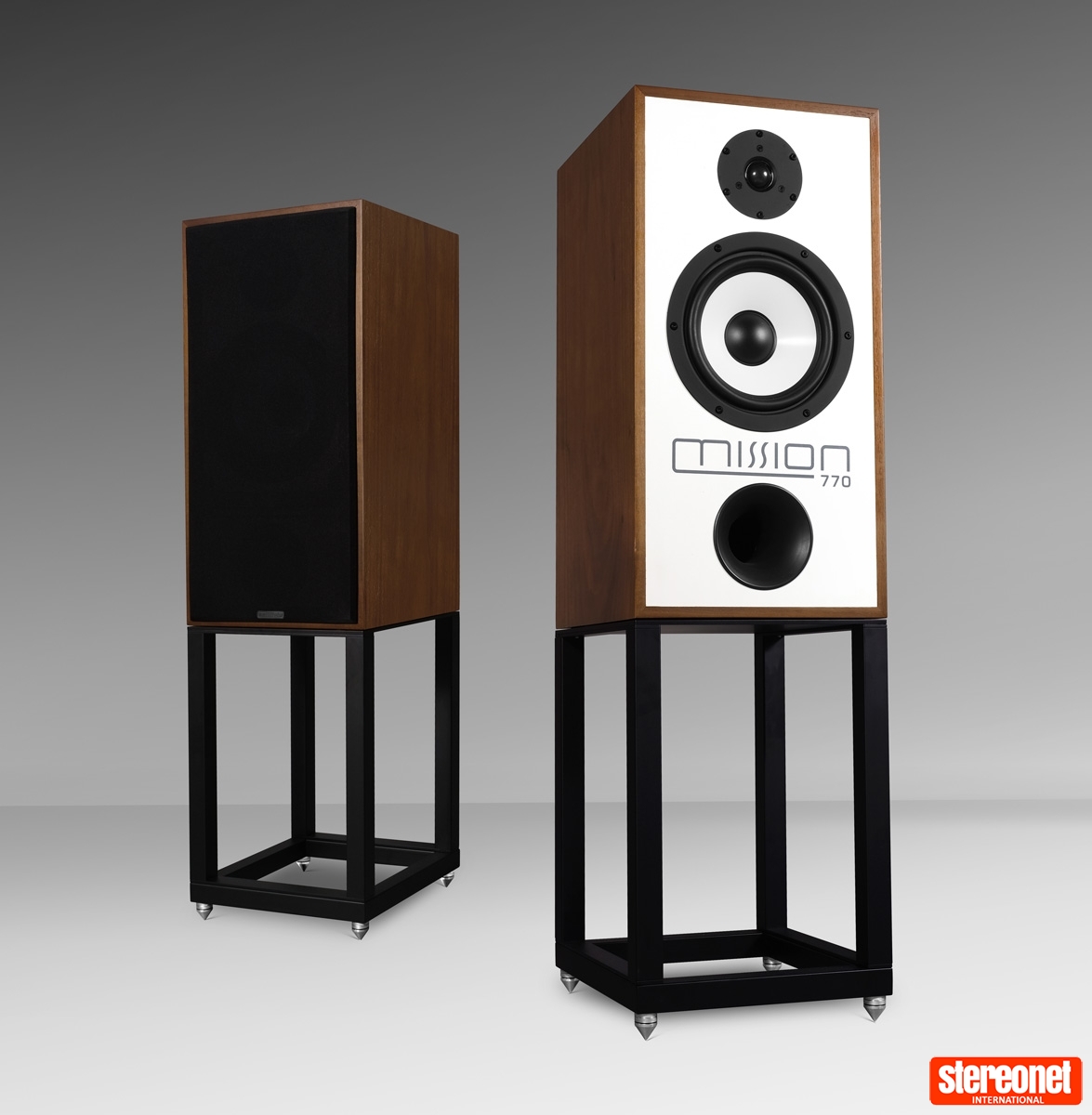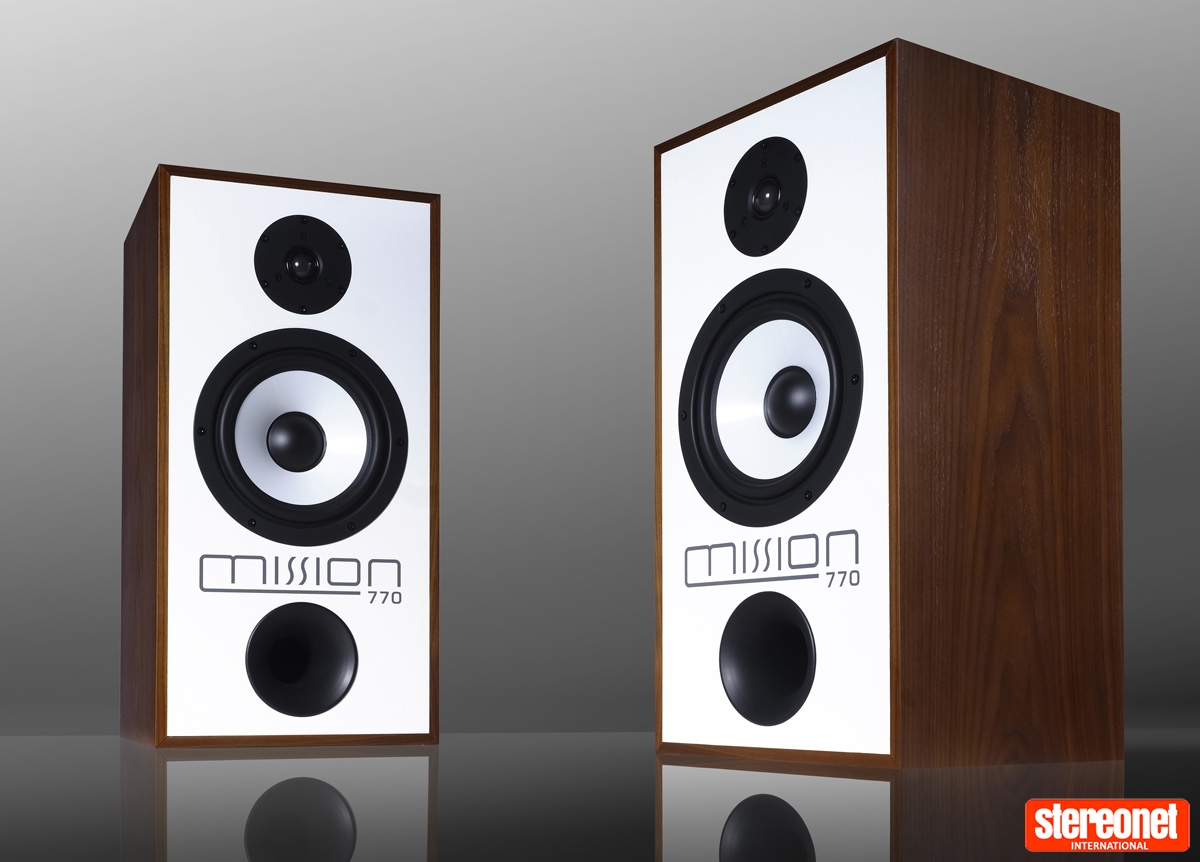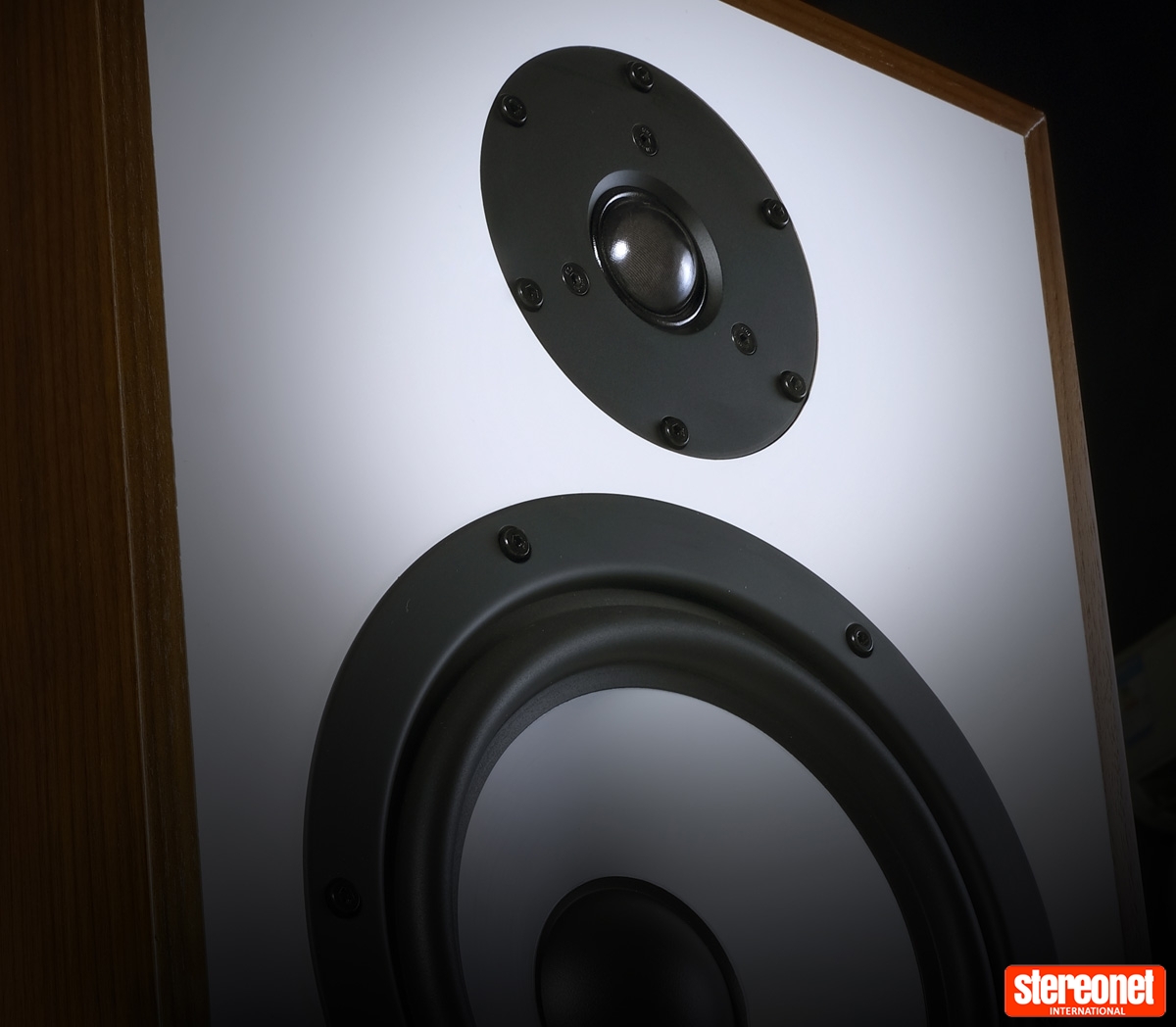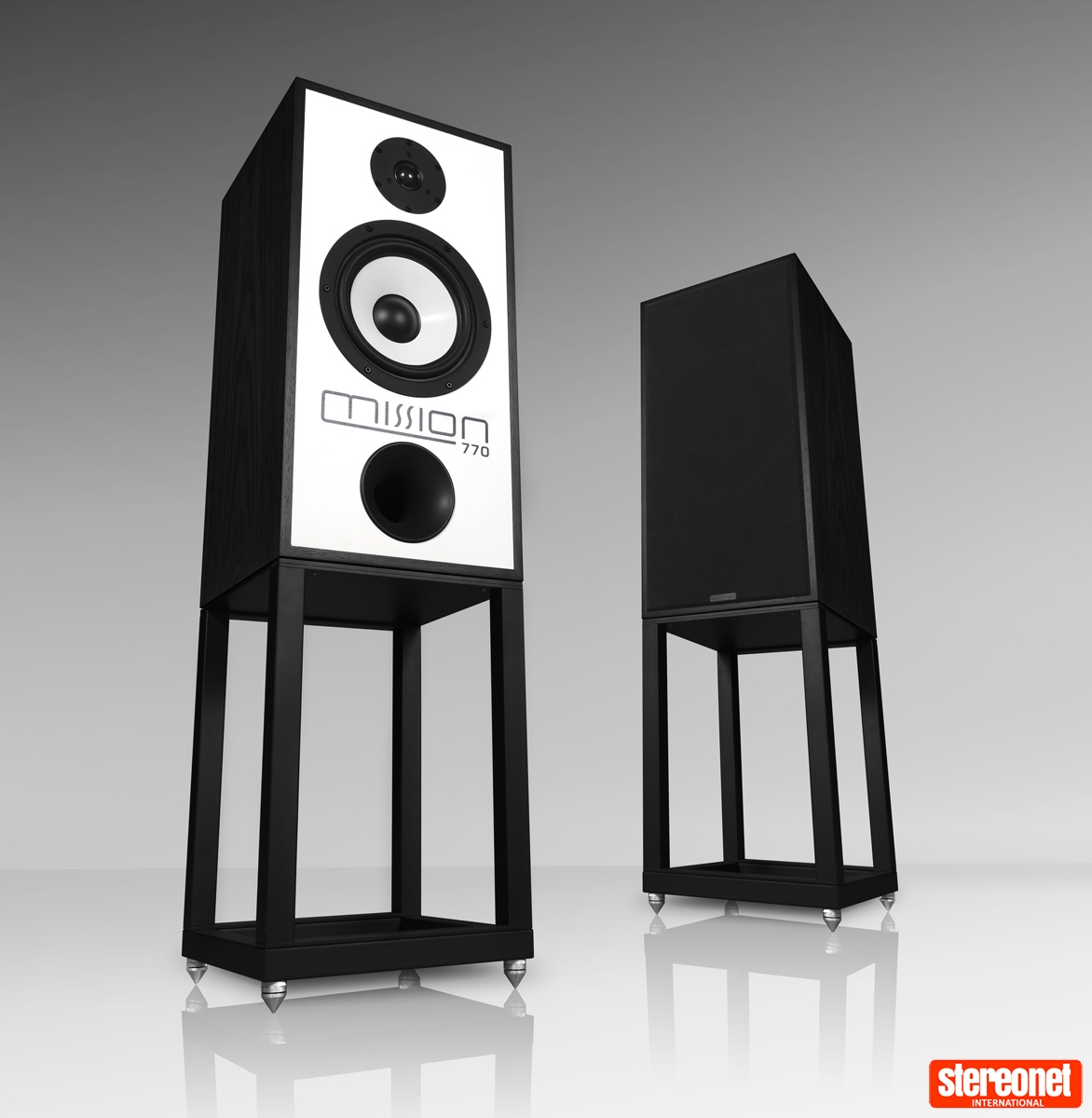Mission 770 Standmount Loudspeaker Review

David Price auditions this sharp-suited remake of a pioneering nineteen seventies loudspeaker…
Mission
770 Standmount Loudspeaker
£3,499

Okay, so you're a thrusting young audiophile, and it's 1976. What high-end speaker do you buy? Until the advent of the Mission 770, your choice was more curtailed than perhaps you'd wish. In the UK, the sensible shoes, 'nice tone' BBC-descended designs held sway – from the likes of Spendor, Rogers, Chartwell, KEF, etc., or there were some wild American JBLs, ARs or Klipschs. Oh, and don't forget the long-in-the-tooth but capable Quad ESL-57 electrostatic, dating back to the late fifties.
All well and good then, but what if you wanted something different, a speaker that didn't sound as sedate as the British designs but wasn't as inaccurate as the more fun-sounding US competition? Enter the snazzy new Mission 760, designed by company founder Farad Azima. It was the first loudspeaker to use a polypropylene coned mid/bass driver – something that seemed very special back in the day, but – as we shall see – that wasn't its only claim to fame. Indeed, I would argue that you could even think of it as the world's first-ever 'modern era' speaker.
First, a quick look around the 'original gangsta' 770 from 1976. It was a largish (590x300x290mm, 12kg) standmounter, and like most high-end speakers back then, it had a wide front baffle, but unlike them, it was reflex ported. Although most of its rivals had three or even four drive units, the Mission was 'just' a 2-way, so that really set it out from the crowd. Still, it had excellent quoted power handling (25 to 200W RMS), an amp-friendly nominal impedance (8 ohms) and an unusually high sensitivity figure of 89dB/1w/1m. Its relatively light and responsive 214mm SEAS polypropylene copolymer mid/bass unit was fast and loud. Also, the unusually thin (but well-damped) cabinet was designed to not store energy, giving a surprisingly engaging and nimble sound.

Its mid/bass driver, and cabinet were innovative then, but there was another defining characteristic of its design that history has paid less attention to. Peter Comeau, a highly respected hi-fi writer for Hi-Fi Answers magazine back in the late nineteen seventies, explained that designer Farad Azima, “pursued musical performance with a level of of missionary-like zeal, roping in magazine editors for their opinions of his latest crossover tweaks. The measurements, made at Kings Langley by a BBC engineer, coincided with trials of different cabinet constructions and then late night listening sessions with Paul Benson, then editor of Hi-Fi Answers or John Atkinson who was at Hi-Fi News.”
In other words, great care was paid to the final 'voicing' of the 770. This may not sound like a big deal now, but for the mid-seventies, it was pretty far out; what some called the 'cult' of subjectivism was very much frowned upon in (then) contemporary speaker design circles – where everything about sound could be measured with an oscilloscope and/or BRÜEL & KJÆR frequency analyser. Of course, Farad did all his homework as far as technical measuring was concerned, but he also spent much time tweaking the (unusually simple) crossover design to make the speaker as satisfying to listen to, as he could.
This paid off in spades and coincided with a move towards more subjective reviewing, at least in the UK hi-fi press. Until the mid-seventies, it was perfectly normal to read two or even three-page hi-fi reviews with just one paragraph devoted to the product's sound quality. Everything else in the text would have been endless facts and figures taken from empirical measurements. Yet by the end of the decade, hi-fi magazines were beginning to leave this style behind and give a much more immersive feeling of listening to the product being reviewed, in words. “Among others, it was Paul Benson's revelatory review in Hi-Fi Answers that described the magic of the musicality of the 770, which was like a breath of fresh air amongst loudspeakers”, says Peter Comeau.

Peter was at the vanguard of this style of writing, right at the time and place the Mission 770 was launched. So how odd it is that he is – in his capacity of design director at International Audio Group (IAG) – the designer of the brand new Mission 770! “I witnessed hearing some of the prototypes that Farad brought round to Paul Benson's flat. Hi-fi was a lot of fun back in then as the subjective movement was just growing and I was one of the 'Gang of Three' reviewers who jumped on the subjective wagon. The others were Dave Berriman and Carl Anthony”, Peter tells me.
He continues: “The 770 was a real breakthrough for enjoyable loudspeakers. The closest I'd come to anything similar was the Gale GS401a and the first version of the Dahlquist DQ10, both of which were much more expensive, and horrendous to drive. The 770 seemed to marry the midband of the Spendor BC1 to a more articulate bass and detailed treble. But its liveliness just made you want to get up and dance!”

UP CLOSE
For the new 770, Peter says he has “worked hard to match and, hopefully, exceed” the performance of the original. If you take a close look at the specs, it's quite spooky. On the outside, at least, the old and new versions look very similar. The new speaker is a bit deeper and noticeably heavier – at 590x300x322mm and 19.2kg – yet it keeps many of the original design aspects. As before, it's a 2-way, and now sports a specially designed 28mm microfibre dome tweeter and 200mm mineral-loaded polypropylene mid/bass cone.

Peter reckons that the original's sensitivity wasn't quite the 89dB figure that Mission claimed, but more like 86dB – which was still a little above average for the day. The new speaker, he tells me, really is 88dB – and also has a nominal impedance of 8 ohms, so it is easy to drive. The same power handling is quoted as the oldie, plus a frequency response of 42Hz to 20kHz (±3dB). The original was listed at 40Hz to 20kHz, so again this is questionable as the new speaker's cabinet volume is noticeably larger at 38.5 litres. “The midband is lively and open and enables you to easily hear through to the recording. But it's the sense of fun and musical enjoyment that I wanted to capture”, he says.
The modern 770 is better built, and interestingly for IAG – which normally builds everything in China – this is made in the UK. The cabinet comes not from China but from Timberworx near Sheffield, which supplies many British speaker companies. It's a handsome-looking thing, in its self-consciously retro way. It comes in a choice of walnut or black real wood veneers, and the front baffle is white laminated. It pays homage to the original's BBC-influenced technique of a thin-wall cabinet damped by mass loading with bitumen pads, but actually has a twin wall sandwich of high-density MDF and particleboard bonded by a layer of high damping glue. Peter says its panel resonance is “well below audibility.” Internal bracing is used, and an internal absorption layer of acoustic foam and fibre is applied to the inside.

The new mid/bass driver has a far superior motor system to take account of modern power handling and dynamic requirements, but as per the original is built on to a 200mm diecast chassis with large rear 'windows' to reduce early reflections back through the cone. The new cone isn't just polypropylene, but uses mineral loading to increase stiffness without adding too much weight. A low-density nitrile surround is employed. Above 2.9kHz, a new damped 28mm microfibre dome tweeter takes over. Instead of the cardboard tube used in the old model, the new speaker uses a bass reflex port which is strongly flared at both inlet and outlet to smooth airflow.
The original 770 crossover was very simple, with a single coil plus a resistor, capacitor and coil combination. The new speaker tries to keep to this philosophy but adds a few extra elements for a smoother response. Peter says that it needed over 170 circuit iterations before the final spec was settled upon. It employs short signal paths and uses high-quality components, such as polypropylene capacitors and air-cored inductors. As before, I am assured that a lot of listening took place before the production version of this speaker was signed off.

THE LISTENING
In the same way that the new model's looks are strongly reminiscent of the seventies classic – but freshened up – so is the sound. Having heard the original 770 at length and even once owning a pair, I can say there's definitely a family resemblance, sonically speaking. At the same time though, pretty much all the 'issues' that the original design had have now been dealt with, and the result is that – in truth – this is a far superior speaker.
The original had an accessible, enthusiastic sort of character with a clean tonality and an open midband – this 'sonic footprint' then transferred on to many subsequent Mission speakers. The new 770 has this too, but gains a much stronger backbone and a greater sense of unflappability. It's less music-dependant, less coloured, more detailed and more dynamic. Yet, at the same time, it's no slouch with rhythms and has an effortless, unforced quality that you don't get from your average 'tower' floor stander these days.
For example, the sublime synthpop that is Seconds by The Human League showed its fine clarity – that quintessential 'clean' Mission midband. I heard a lot of what is in this excellent early eighties pop recording, as the new 770's mid/bass driver did a very good job of letting me peer into the mix. There's much less of that characteristic polypropylene 'quack' with this speaker than in the original; older polyprop cones had a slightly nasal nature that simply isn't here now. Indeed, this speaker sounds altogether faster, tighter and less coloured.

This track also showed the new 770 to be way better than the old one at low frequencies. The seismic synth bass started and stopped faster, and drew less attention to itself as there was next-to no sense of overhang, and very little noise from the reflex port. This is not a speaker that naturally booms when given serious amounts of low bass to deal with. At the opposite end of the frequency spectrum, the new tweeter proved a model of decorum, with no nasty noises – even with cranked-up ride cymbals such as those on Rush's Subdivisons. I wouldn't say the new 770 has the best treble at the price – that award goes to NEAT's Majistra, to my ears – but it's decently detailed and integrates very well with the crisp, clean and open midband.
The new 770 isn't quite the most transparent design around, but still gives you a good picture of what's going on in terms of low-level detail resolution. Fleetwood Mac's Don't Stop was most impressive, this speaker conjuring up a vivid recorded acoustic with decent tonal colour and lots of fine detail. But more impressive even than this was the way the new Mission belted the song out; it really seemed to be enjoying itself as it merrily rolled along and shifted serious amounts of air around the room. As well as starting and stopping more niftily than you might expect from a retro-styled speaker, it delivered surprisingly powerful dynamic swings too.

Indeed, Private Life from Grace Jones was an unalloyed pleasure. This can be a flat, boring dirge through the wrong speaker, but via the new Mission, it came alive. The track is packed with subtle percussion effects from Sly & Robbie, and this speaker really got to grips with these, making for a highly involving sound. Again, I've heard more detail elsewhere than via the new 770, but the Mission needs to make no excuses as far as the fun factor goes. The percussive rim shots and kettle drum thumps were dramatic and satisfyingly visceral; this speaker belted everything out with ease, staying smooth and composed even at really high volumes.
Overall then, it's a wonderfully enjoyable thing. It sounds dextrous, detailed, articulate and expressive and makes pretty much any type of music that you play with it fun. Yet if you listen closely, you can hear it doing some things wrong – or at least not quite right. Although the new 770 makes an impressively capacious, room-filling sound, I have heard better speakers at the price for stereo imaging and bass extension. ATC's superb SCM40 is one such example, with a gutsier, more expansive sound. Yet still, the new 770 could serve up a satisfyingly wide soundstage, just not quite as precisely laid out in terms of the location of instruments in the mix. Despite this, I would still say that the Mission sounds more fun, which is really saying something against an ATC.

THE VERDICT
 Although the new Mission 770 is technically superior to the original, it retains its predecessor's charm. It makes pretty much any type of music you play a real occasion. It doesn't do this by adding pleasant-sounding artefacts, though. Instead, it's clean enough to take you directly to the recording itself, at which point it steps aside as much as possible. I liked this new, retro-styled loudspeaker a hell of a lot – and the way it sounds suggests to me that designer Peter Comeau had plenty of fun voicing it, too. Nice work, if you can get it!
Although the new Mission 770 is technically superior to the original, it retains its predecessor's charm. It makes pretty much any type of music you play a real occasion. It doesn't do this by adding pleasant-sounding artefacts, though. Instead, it's clean enough to take you directly to the recording itself, at which point it steps aside as much as possible. I liked this new, retro-styled loudspeaker a hell of a lot – and the way it sounds suggests to me that designer Peter Comeau had plenty of fun voicing it, too. Nice work, if you can get it!
For more information visit Mission
David Price
David started his career in 1993 writing for Hi-Fi World and went on to edit the magazine for nearly a decade. He was then made Editor of Hi-Fi Choice and continued to freelance for it and Hi-Fi News until becoming StereoNET’s Editor-in-Chief.
Posted in:Hi-Fi Loudspeakers Bookshelf / Standmount Applause Awards 2022
Tags: mission iag
JOIN IN THE DISCUSSION
Want to share your opinion or get advice from other enthusiasts? Then head into the Message Forums where thousands of other enthusiasts are communicating on a daily basis.
CLICK HERE FOR FREE MEMBERSHIP





